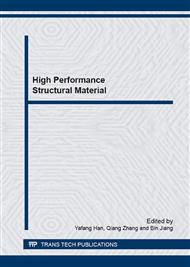[1]
M.J. Goulette. The future costs less-high temperature materials form an aeroenging perspective[C]/ R.D. Kissinger, et al. Superalloys 1996. Warrendale PA: TMS, 1996: 3-6.
DOI: 10.7449/1996/superalloys_1996_3_6
Google Scholar
[2]
B. B Seth. Superalloys-the utility gas turbine perspective[C]/ T.M. Pollock, et al. Superalloys 2000. Warrendale PA: TMS, 2000: 3-16.
DOI: 10.7449/2000/superalloys_2000_3_16
Google Scholar
[3]
G.L. Erickson. The development and application of CMSX-10[C] / R.D. Kissinger, et al. Superaloys1996. PA: Warrendale, TMS, 1996: 35-44.
Google Scholar
[4]
Y.F. Gu, C. Cui, H. Harada, T. Fukuda, D. Ping, A. Mistsuasi, K. Kato, T. Kobayashi, J. Fujioka. Development of Ni-Co Base Alloys for High-Temperature Disk Applications[C]/ R.C. Reed, et al. Superalloys 2008, Seven Springs, 2008, PA: TMS, 2008: 53-61.
DOI: 10.7449/2008/superalloys_2008_53_61
Google Scholar
[5]
X.H. Zhao, Z. H Huang, , Q. Zhang, Q. Yu, H.B. Xu. New Ni3Al-Based Directionally-Solidified Superalloy IC10. J. Aero. Mater., 26(2006): 20-24.
Google Scholar
[6]
Z.P. Xing, X.H. Zhao, Q. Yu, Y.N. Tan, Y.F. Han. Ni3Al base dual phase high temperature structural materials IC10. Mater. Sci. Eng. A, 18(2000): 33-34.
Google Scholar
[7]
Y.W. Fan, S.E. Hou, Z.H. Huang. Effect of Al content on solidification behavior of Ni3Al-base IC10 alloy. Trans. Mater. Heat Treat., 30(2009): 88-92.
Google Scholar
[8]
Y.R. Zheng, Y.L. Cai, Z.C. Ruan, S.W. Ma. Investigation of effect mechanism of hafnium and zirconium in high temperature materials. J. Aero. Mater., 26(2006): 25-34.
Google Scholar
[9]
M.V. Nathal, R.D. Mailer,. The influence of cobalt on the microstructure of the nickel-base superalloy MAR-M247. Metall. Mater. Trans. A, 13A(1982): 1775-1783.
DOI: 10.1007/bf02647833
Google Scholar
[10]
M.V. Nathal, L.J. Ebert. The influence of cobalt, tantalum and tungsten on the microstructure of single crystal nickel-base superalloy. Metall. Mater. Trans. A, 16A(1985): 1849-1862.
DOI: 10.1007/bf02670372
Google Scholar
[11]
Z. Yang, F. Tian, Z. Zheng, Y.X. Zhu. Effect of element factors of a directionally solidified Ni-base supperalloy on hot tear in turbine blades. Acta Metall. Sin., 38(2002): 1191-1194.
Google Scholar
[12]
X.F. Sun, F.S. Yin, J.G. Li, G.C. Hou, Q. Zheng, H.R. Guan, Z.Q. Hu. Solidification behavior of a cast nickel-base superalloy. Acta Metall. Sin., 39(2003): 27-29.
Google Scholar
[13]
Y.J. Sun, J.G. Kang, S.K. Gong. Effects of Ti, Al and Ta on microstructure and properties of Ni-based single crystal superally. Special Casting Nonferrous Alloys., 28(2008): 660-662.
Google Scholar
[14]
Y.R. Zheng, D.T. Zhang. Color metallographic investigation of superalloys and steels[M]. National Defense Industry Press. (1999).
Google Scholar


